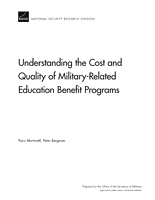| 来源类型 | Research Reports
|
| 规范类型 | 报告
|
| 来源ID | RR-297-OSD
|
| Understanding the Cost and Quality of Military-Related Education Benefit Programs |
| Paco Martorell; Peter Bergman
|
| 发表日期 | 2013
|
| 出版年 | 2013
|
| 页码 | 41
|
| 语种 | 英语
|
| 结论 |
Veterans Can Choose from a Wide Selection of Education Benefit Programs- The two most significant programs are the Montgomery GI Bill (MGIB) and the Post-9/11 GI Bill, which is the largest expansion of benefits since the original GI Bill in 1944.
- The MGIB and Post-9/11 GI Bills are complemented by several other programs, such as the Yellow Ribbon Program and the MGIB-Selected Reserve and the Reserve Educational Assistance Program.
Participation Data Revealed Trends- Nearly half of all veterans separating before 2000 have claimed benefits before the option to do so expires.
- Claim rates are highest for Marines, Hispanic veterans, and for those with higher Armed Forces Qualifying Test scores.
- Take-up rates have been increasing over time, which suggests that an even greater fraction of service members are taking advantage of the Post-9/11 GI Bill (although our data do not allow us to confirm this conjecture).
Little Research Exists on the Impact of Current Educational Assistance Programs on Veterans' Outcomes- Policymakers need better research on quality and quantity of education that veterans receive.
- Policymakers need better research on quality and quantity of education that veterans receive.For-profit colleges are on the rise, charge higher tuition, and target veterans. There are concerns about the educational quality that they provide, and that their students are less likely to complete degree programs and face greater unemployment and student loan burdens.
- The benefit options can be an embarrassment of riches, and veterans may not understand the choices or eligibilities well enough to make the smartest decisions about funding their education.
|
| 摘要 |
- Extensive data collection will help track veterans' outcomes during school and through their transitions into the labor market.
- How tuition subsidies and other benefits affect recruitment, retention, education, and labor-market outcomes should be quantified.
- A rigorous research design should be developed to measure the extent to which benefits affect college choice decisions and how this affects program costs.
- Another metric for consideration should be the consequences of benefit-choice complexity on veterans' choices, financial aid and education.
- Interventions could be devised to reduce this complexity and improve benefit choices.
|
| 主题 | Military Compensation
; Military Education and Training
; Military Recruitment
; Military Veterans
|
| URL | https://www.rand.org/pubs/research_reports/RR297.html
|
| 来源智库 | RAND Corporation (United States)
|
| 资源类型 | 智库出版物
|
| 条目标识符 | http://119.78.100.153/handle/2XGU8XDN/107521
|
推荐引用方式
GB/T 7714 |
Paco Martorell,Peter Bergman. Understanding the Cost and Quality of Military-Related Education Benefit Programs. 2013.
|
|
文件名:
|
1387890421063.gif
|
|
格式:
|
GIF
|

|
文件名:
|
RAND_RR297.pdf
|
|
格式:
|
Adobe PDF
|
除非特别说明,本系统中所有内容都受版权保护,并保留所有权利。